This post was last updated on March 3rd, 2023
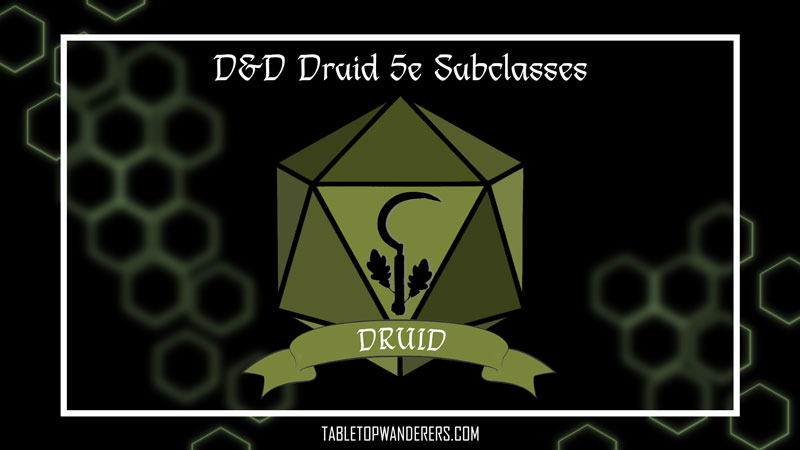
Hi fellow gamer and welcome to another Dungeons & Dragons article, this time focused on the Druid 5e subclasses called Druid Circles.
In my previous Druid level-up guide article I said how I find the level-up process to be one of the most enjoyable parts of any RPG and one of the nuances I prefer when I level up is to find ways to differentiate my character from the rest of the party, which is when subclasses come into play.
There are currently 7 Druid 5e subclasses across different D&D manuals.
For each of them, I’ll write a general overview and at the end of the article, you’ll also find the Druid 5e subclasses ranked following my personal taste which takes multiple factors into consideration, with the role-playing and playstyle potential of the class in the first place.
This post may contain affiliate links. If you click through and make a purchase, I will get a commission at no extra cost to you. See our Affiliate Disclosure.
D&D Druid 5e Subclasses
- Circle of Dreams Druid 5e
- Circle of the Land Druid 5e
- Circle of the Moon Druid 5e
- Circle of the Shepherd Druid 5e
- Circle of Spores Druid 5e
- Circle of Stars Druid 5e
- Circle of Wildfire Druid 5e
College of Dreams Druid 5e
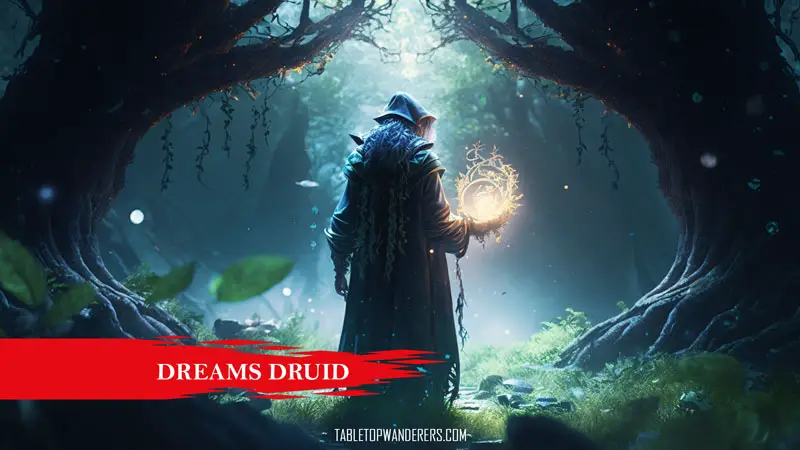
Subclass Overview
Members of the Circle of Dreams are Druids who come from areas with significant connections to the Feywild and its dreamlike worlds.
The lands these druids guard are dazzling, bountiful places, where fantasy and reality blend together and the tired might find rest.
These druids want to fill the world with dreamy wonder as their power heals wounds and brings pleasure to sad hearts.
D&D Manual: Xanathar’s Guide to Everything.
Dreams Druid Main Features
Balm of the Summer Court – 2nd level
You have a pool of fey energy, represented by a number of d6s equal to your druid level, which you can use to heal your allies. You can take some of those dice (equal to half your druid level or less) and roll them. The target regains a number of hit points equal to the total of your roll and it also gains 1 temporary hit point per die spent.
Hearth of Moonlight and Shadow – 6th level
At the start of a short or long rest, you can create a 30-foot-radius sphere of magic that is invisible to others.
When you and your allies are inside the sphere you gain a +5 bonus to Dexterity (Stealth) and Wisdom (Perception) checks and all the flames such torches or a campfire aren’t visible from outside.
Hidden Paths – 10th level
You can teleport up to 60 feet to an empty area you can see as a bonus action on your turn. You can also use this action to transfer one willing creature you touch up to 30 feet to a visible empty spot.
Walker in Dreams – 14th level
You can perform one of the following spells after you have finished a short rest without using a spell slot or any material components: Dream (you’ll be the messenger), Scrying, or Teleportation Circle.
This application of Teleportation Circle is unique as it opens a gateway to the last place you finished a long rest on your current plane of existence, rather than to a permanent teleportation circle.
Party Role
Support and Healer.
Circle of the Land Druid 5e
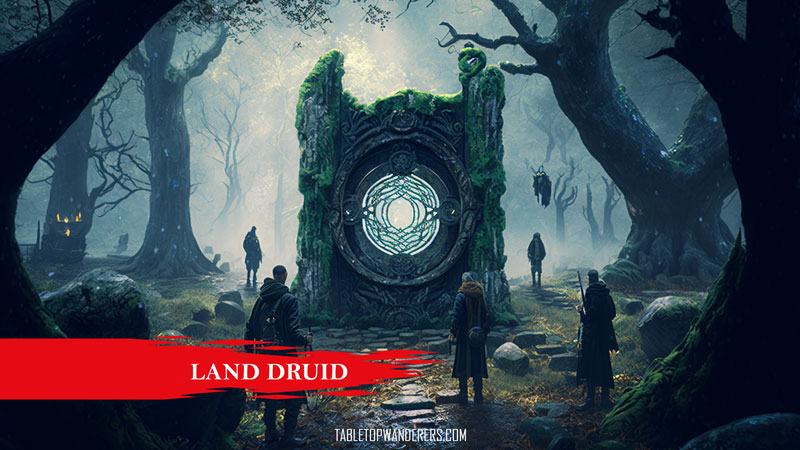
Subclass Overview
The mystics and sages that make up the Circle of the Land preserve ceremonies and knowledge from the past through oral heritage. These druids gather in sacred circles made of trees or standing stones where they speak in druidic to whisper primitive secrets.
Being a member of this circle means that your magic is influenced by the land where you were initiated into the circle’s mysterious rites.
D&D Manual: Player’s Handbook.
Land Druid Main Features
Bonus Cantrip – 2nd level
You learn one additional druid cantrip of your choice.
Natural Recovery – 2nd level
During a short rest you can choose expended spell slots to recover.
The combined level of the spell slots can’t exceed half your druid level and none of the slots can be 6th level or higher.
Circle Spells – 3rd level
Your spiritual connection to the land where you became a Druid grants you the ability to cast certain spells.
Starting from the 3rd level you can choose a type of land among arctic, coast, desert, forest, grassland, mountain, swamp or Underdark and learn the associated spells to that biome.
Land’s Stride – 6th level
Moving through nonmagical difficult terrain doesn’t cost you extra movement and you can also go through nonmagical plants without being slowed or suffering damage from them.
You also have advantage on saving throws against plants that have been magically created or manipulated to obstruct movement.
Nature’s Ward – 10th level
You can’t be charmed or frightened by elementals or fey, and you are immune to poison and disease.
Nature’s Sanctuary – 14th level
When a beast or plant creature attacks you, that creature must make a Wisdom saving throw; if it fails, the creature must choose another target or the attack will automatically miss.
Party Role
Support and Area Control.
Circle of the Moon Druid 5e
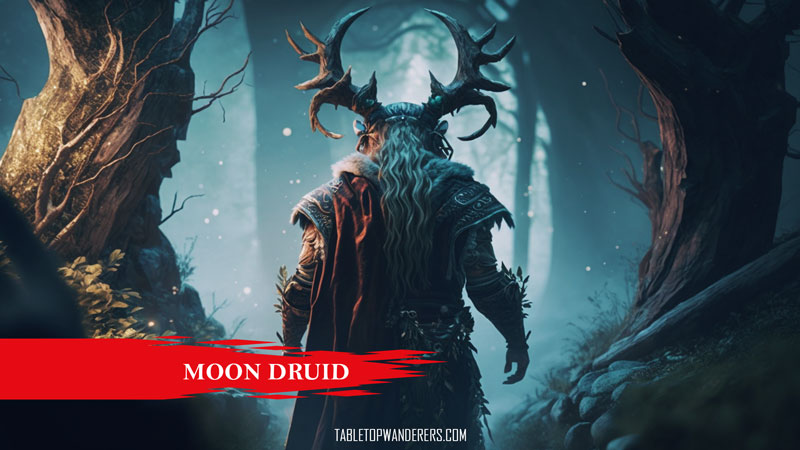
Subclass Overview
The Circle of the Moon’s druids are ferocious defenders of the wilderness. Under the full moon, their order congregates to exchange information and warnings.
They explore the wildest regions, sometimes travelling for weeks at a time without coming across another humanoid creature.
A druid of this circle may prowl as a tiger one night, fly over the treetops as an eagle the next, and crash through the undergrowth in bear shape in order to repel an intruding monster.
D&D Manual: Player’s Handbook.
Moon Druid Main Features
Combat Wild Shape – 2nd level
You can now use Wild Shape as a bonus action rather than an action during your turn, and while you’re transformed you can expend a spell slot to gain 1d8 hit points for each level of the spell slot spent.
Circle Forms – 2nd level
You can use your Wild Shape to transform into beasts that have a challenge rating as high as 1.
Starting at the 6th level, you can transform into a beast with a challenge rating as high as your druid level divided by 3, rounded down.
Primal Strike – 6th level
For the purpose of overcoming resistance and immunity to nonmagical attacks and damage, your attacks while in beast form count as magical attacks.
Elemental Wild Shape – 10th level
You can expend two uses of Wild Shape at once to transform into an air elemental, an earth elemental, a fire elemental, or a water elemental.
Thousand Forms – 14th level
You have learned to use magic to alter your physical form in more subtle ways, therefore you can cast the Alter Self spell whenever you want.
Party Role
Versatile Support oriented to Damage.
Circle of the Shepherd Druid 5e
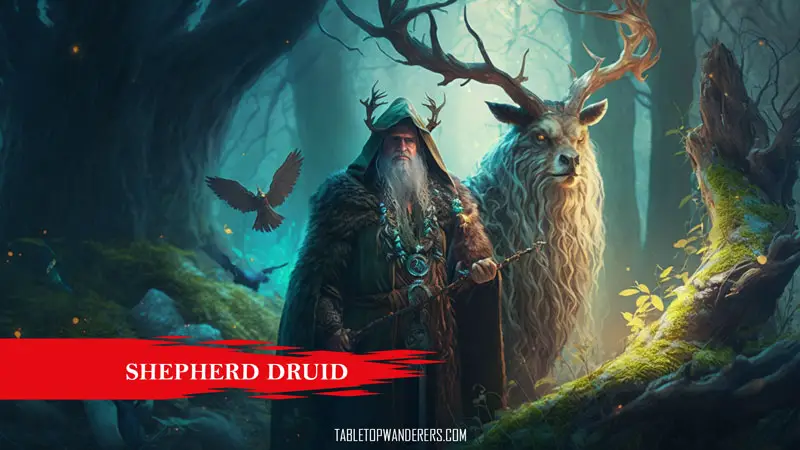
Subclass Overview
The Circle of the Shepherd’s druids strive to protect animals and fey creatures that are unable of defending themselves because they know that all living things have a place in the natural world.
Many of these druids choose to live in remote areas distant from cities and settlements where they can spend their days conversing with animals and fey creatures of the wild.
Shepherds, as they are known, see such creatures as their charges and they often become adventurers and travel the world in order to combat those foes that harm their charges.
D&D Manual: Xanathar’s Guide to Everything.
Shepherd Druid Main Features
Speech of the Woods – 2nd level
You have the ability to speak with animals and beasts and you know how to speak, read and write Sylvan.
Beasts can understand you and you understand their motions and noises.
Spirit Totem – 2nd level
As a bonus action you can magically call an incorporeal spirit to a point within 60 feet of you that you can see.
Around that spot, the aura of the spirit extends 30 feet in all directions and depending on which spirit you have summoned, the aura has different effects.
- Bear Spirit: each creature of your choice in the aura obtains temporary hit points equal to 5 + your druid level. Moreover, while under the aura, you and your allies have an advantage on Strength checks and Strength saving throws.
- Hawk Spirit: you can use your reaction to give an attack roll advantage when a creature makes an attack on a target within the spirit’s aura. Furthermore, while in the aura, you and your allies have an advantage on Wisdom (Perception) checks.
- Unicorn Spirit: you and your allies gain advantage on all ability checks made to detect creatures in the spirit’s aura. Also, if you cast a spell using a spell slot that restores hit points to any creature inside or outside the aura, each creature of your choice in the aura also regains hit points equal to your druid level.
Mighty Summoner – 6th level
Each beast and fey you summoned using one of your spells gain two benefits:
- The creature shows up with two extra hit points per Hit Die it has, resulting in more hit points than usual.
- The damage from its natural weapons is considered magical for the purpose of overcoming immunity and resistance to nonmagical attacks and damage.
Guardian Spirit – 10th level
A beast or fey that you summoned or generated with a spell gains hit points equal to half your druid level when it completes its turn inside the aura of your Spirit Totem.
Faithful Summons – 14th level
If you are reduced to 0 hit points or become incapacitated against your will, you can immediately benefit from the effects of Conjure Animals as though it were cast with a 9th-level spell slot.
It summons four beasts of your choice that are challenge rating 2 or lower and the conjured beasts will appear within 20 feet of you.
They defend you from damage and engage your enemies if you don’t give them any orders. The magic requires no concentration and lasts for an hour, or until you dismiss it.
Party Role
Striker, Defender, Summoner and Healer.
Circle of Spores Druid 5e
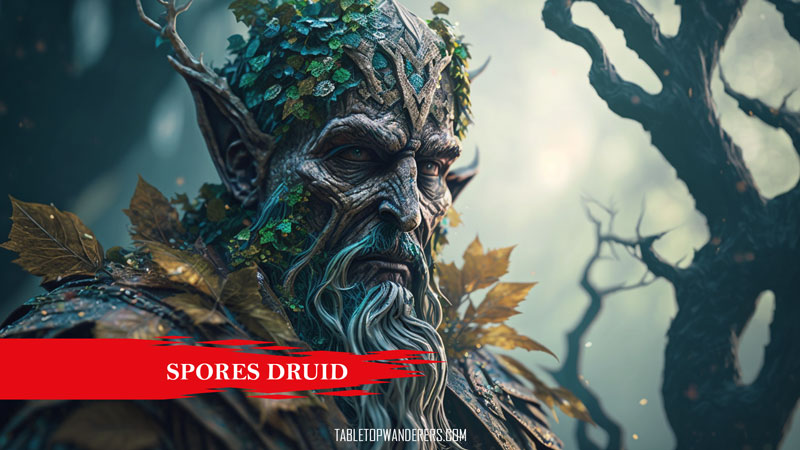
Subclass Overview
Druids of the Circle of Spores embrace decay and they perceive in mold and other fungi the capacity to convert lifeless matter into a profusion of life.
According to these druids, life and death are interconnected components of a larger cycle that go from one to the other and back again.
Death is not the end of life but it is rather a state change in which life takes on a new form. They think the natural cycle is at its healthiest when each part of it is alive and evolving, therefore they’ll fight whoever tries to break it.
D&D Manual: Tasha’s Cauldron of Everything.
Spores Druid Main Features
Circle Spells – 2nd level
You learn the Chill Touch cantrip, and from the 3rd level you’ll gain access to the subclass spells.
Halo of Spores – 2nd level
Invisible necrotic spores surround you, causing no harm until you release them on a nearby creature.
When a creature moves in a space within 10 feet of you or begins its turn there, you may use your reaction to deal 1d4 necrotic damage to it unless the creature makes a successful CON saving throw.
Symbiotic Entity – 2nd level
Instead of changing into a beast form, you can use your Wild Shape feature as an action to awaken fungal spores that gives you 4 temporary hit points for each of your Druid level.
When Symbiotic Entity is active you also gain some additional effects:
- When you deal Halo of Spores damage, roll the damage die a second time and add it to the total.
- Your melee attacks hit any target for an additional 1d6 necrotic damage.
Fungal Infestation – 6th level
Your spores acquire the capacity to infest and inhabit a corpse. You can use your reaction to animate a Small or Medium-sized beast or humanoid that has passed away within 10 feet of you, giving it the ability to get up right away with 1 hit point.
The monster makes use of the Monster Manual’s Zombie stat block and its turn in battle follows yours instantly.
It only responds to your mental orders and can only use the Attack action, which triggers a single melee strike.
Spreading Spores – 10th level
You can launch spores up to 30 feet away as a bonus action while your Symbiotic Entity skill is active, and they will spin for 1 minute in a 10-foot cube.
If a creature enters the cube or begins its turn there, it suffers damage from your Halo of Spores unless it makes a successful CON saving throw.
Fungal Body – 14th level
Your body has been altered by fungal spores and as a result you can’t be blinded, deafened, frightened, or poisoned and any critical hits against you only count as regular hits.
Party Role
Offensive Support.
Circle of Stars Druid 5e
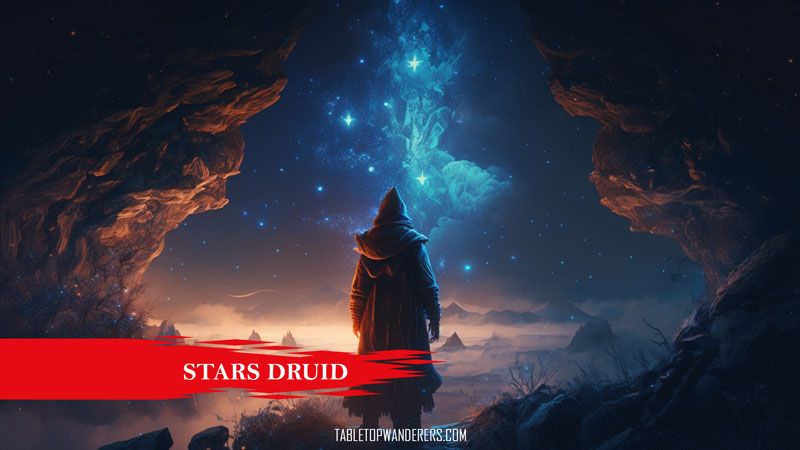
Subclass Overview
Druids have access to the power of the stars through the Circle of Stars. From the dawn of time, these druids have studied cosmic patterns, unearthing mysteries hidden in the stars. The Circle of the Stars strives to use cosmic forces by exposing and comprehending these mysteries.
The constellations and the impact of the stars on the planet are noted by several druids in this circle.
Some organisations record these findings at megalithic monuments, which act as enigmatic knowledge libraries. Stone circles, pyramids, petroglyphs, and subterranean temples are a few examples of repositories that may be used to store sacred information even in the event of a major catastrophe.
D&D Manual: Tasha’s Cauldron of Everything.
Stars Druid Main Features
Star Map – 2nd level
In the process of your heavenly studies, you have built a star chart which is a Tiny item that serves as a spellcasting focus for your druid spells.
To determine its form you can either roll on the Star Map table or choose one.
When you have this object in your hands, you gain some benefits:
- You know the Guidance cantrip.
- You have the Guiding Bolt spell prepared. It counts as a druid spell for you, and it doesn’t count against the number of spells you can have prepared.
- You can cast Guiding Bolt without expending a spell slot. You can do so a number of times equal to your proficiency bonus, and you regain all expended uses when you finish a long rest.
Starry Form – 2nd level
You are able to use the power of constellations to change your shape.
You can spend one use of your Wild Shape feature as a bonus action to assume a starry shape rather than transforming into a beast.
The shape of the constellation you want to transform into gives you different benefits:
- Archer: when you activate this form, and as a bonus action on your subsequent turns while it lasts, you can perform a ranged spell attack by firing a glowing arrow that targets one creature within 60 feet of you. When the attack strikes, it delivers radiant damage of 1d8 + your Wisdom modifier.
- Chalice: you and any other creature within 30 feet of you can gain health points equal to 1d8 + your Wisdom modifier whenever a spell that restores a creature’s hit points is cast using a spell slot.
- Dragon: when you make an Intelligence or a Wisdom check or a Constitution saving throw to maintain concentration on a spell, you can treat a d20 roll of 9 or lower as a 10.
Cosmic Omen – 6th level
You can check your Star Map for signs after a long rest and if you decide to do so, roll a die. Until you finish your next long rest, you receive access to a unique reaction based on whether you rolled an even or an odd number on the die.
- Weal (even): you can use your reaction to roll a d6 and add the result to the total whenever a creature that you can see within 30 feet of you is ready to make an attack roll, a saving throw, or an ability check.
- Woe (odd): you have the option to use your reaction to roll a d6 and deduct the result from any attack roll, saving throw, or ability check that a creature you can see within 30 feet of you is about to make.
Twinkling Constellations – 10th level
The constellations of your Starry Form improve. The 1d8 of the Archer and the Chalice becomes 2d8, and while the Dragon is active, you have a flying speed of 20 feet and can hover.
Also, when in your Starry Form, you can alter which constellation glimmers on your body at the beginning of each of your turns.
Full of Stars – 14th level
Your body becomes almost incorporeal while you’re in Starry Form and this gives you resistance to bludgeoning, slashing and piercing damage.
Party Role
Damage and Healing.
Circle of Wildfire Druid 5e
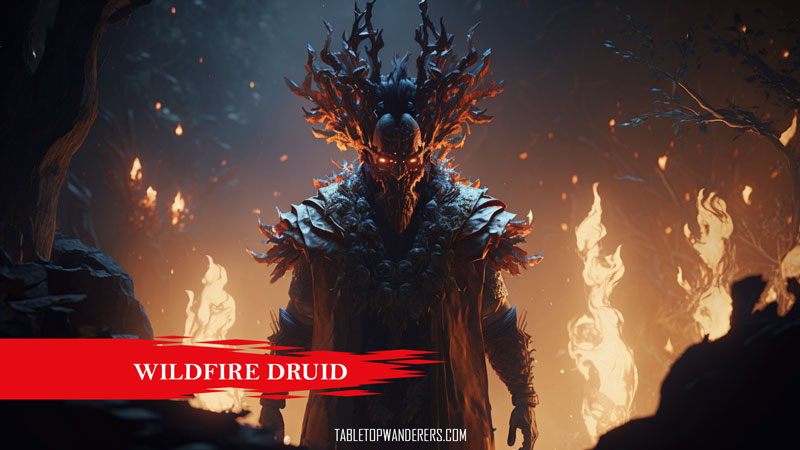
Subclass Overview
Druids in the Circle of Wildfire are aware that sometimes destruction precedes creation, as when a forest fire encourages subsequent development.
These druids form a connection with a primal spirit that possesses both a destructive and a creative force, enabling the druids to direct controlled flames that destroy something while reviving something else.
D&D Manual: Tasha’s Cauldron of Everything.
Wildfire Druid Main Features
Circle Spells – 2nd level
You have a connection with a wildfire spirit, a primordial source of creation and extinction. This connection grants you access to certain spells listed on the Circle of Wildfire Spells table.
Summon Wildfire Spirit – 2nd level
You can call forth the primordial spirit connected to your soul. You can use one of your Wild Shape uses and call your wildfire spirit rather than taking on a beast shape.
The spirit manifests in a place of your choosing that is empty and within 30 feet of you. As the spirit manifests, every creature (apart from you) within 10 feet of it must succeed on a Dexterity saving throw versus your spell save DC or suffer 2d6 fire damage.
The spirit is obedient to your commands and friendly to you and your party.
You can choose which action the spirit will take between these two:
- Flame Seed: 60 feet single ranged weapon attack. Hit equals 1d6 + proficiency bonus fire damage.
- Fiery Teleportation: the spirit and each willing creature of your choice within 5 feet of it teleport up to 15 feet to unoccupied spaces you can see. Then each creature within 5 feet of the space that the spirit left must succeed on a DEX saving throw against your spell save DC or take 1d6 + proficiency bonus fire damage.
Enhanced Bond – 6th level
While your wildfire spirit is summoned, whenever you perform a spell that causes fire damage or regenerates hit points, roll a d8, and you get a bonus equal to the number rolled.
Also, when you cast a spell that has range, the spell can originate from you or your wildfire spirit.
Cauterizing Flames – 10th level
When a Small or larger creature dies within 30 feet of you or your wildfire spirit, a harmless ghostly flame emerges from the dead body and flickers there for one minute.
When a creature that you can see enters that space, you can use your reaction to blow out the ghostly flame and either heal or damage that creature with fire. Your damage or healing power equals to 2d10 + your Wisdom modifier.
Blazing Revival – 14th level
When you lose all of your hit points and become unconscious as a result, you can make the Wildfire spirit lose all of its hit points if it is within 120 feet of you and you can regain half your life and immediately stand up.
Party Role
Damage, Crowd Control and Healing.
D&D Druid 5e Subclasses Ranked
Here we are at the end of the article to wrap everything up.
After the brief overview of each Druid 5e subclass, I’d like to put a number next to each one of them in order to create a personal rank.
As I said at the beginning of the article this rank takes into consideration multiple factors and not just the actual strength:
7th • Circle of Dreams Druid: this subclass has some useful features such as Hidden Path, but most of them are very situational and quite tricky to pull off. Very good archetype if you want an additional healer and rescuer in the party but other than that I don’t find this subclass very fun to play.
6th • Circle of the Land Druid: perfect subclass for whoever wants to play a spellcaster as by choosing this archetype your character will be heavily invested in learning and casting new unique spells.
Very strong if the campaign you’re playing involves beasts and plants since you’ll be very effective against them, but other than that I find the Land Druid a bit outdated and overtaken by the new subclasses released since the player’s handbook.
5th • Circle of Spores Druid: Similarly to the Moon Druid archetype this subclass is voted to melee combat although the use of the Wild Shape feature is very different.
A Spores Druid is unlikely to turn into its beast form as that would limit the number of features it can use.
I think it’s an awesome subclass with a cool lore flavour and mechanics, but it requires you to optimize the build to make it efficient due to its difficulty to play.
I wished there weren’t as many saving throws to ruin the fun.
4th • Circle of the Wildfire Druid: this archetype grants you a pet, as if you were a Warlock or a Sorcerer, and I kind of appreciate a bit of diversification if you want to play a different kind of Druid.
This subclass could have been probably placed higher up in the ranks if there were more features revolving around the fire element, for example, elemental resistance, a flamy aura, splash damage and so on.
Still, it is a strong archetype.
3rd • Circle of Stars Druid: a very strong archetype that, similarly to the Shepherd and Moon Druids, allows you to take on the role of different characters. The main core gameplay mechanic revolves around Starry Form and most of the time you’ll be required to make a wise strategic choice on which form you want to take since you have limited uses of this feature. When you reach level 10 you can change your choice on each turn and this will be of tremendous value to the party.
If you play your cards well, both you and your friends will have an absolute blast playing this archetype.
2nd • Circle of the Shepherd Druid: if you like a versatile Druid this is the best choice for you. Thanks to this subclass features your character can be a support, damage dealer, defender and by far the best summoner in the party.
I love the Shepherd Druid as it allows you to be the perfect fit for the party in according to what the story requires. Your friends will love you!
1st • Circle of the Moon Druid: very versatile Druid subclass as this archetype allows you to transform into different beasts depending on your party composition. Similarly to the Circle of the Shepherd, you can be a Striker, a Tank, a Defensor or a Healer. I personally love building a Tank-oriented Druid when choosing this subclass. Even though it’s one of the first archetypes invented, I think it hasn’t yet been surpassed by any other subclass and in fact, I still think it’s the best Druid archetype.